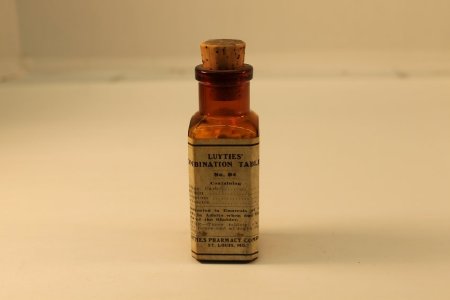Object ID Number:
PH190
Object Name:
Medicine Bottles
Type:
Combination Tablets
Manufactured from:
1870
Manufactured to:
1880
Description / History:
Small mold blown glass bottle containing homeopathic white tablets. White label reads, "Luyties Combination Tablets No. 84".
Dr. Herman Luyties studied under homeopathic doctors in Germany before coming to America to open a small homeopathic pharmacy in St. Louis. From 1853 on he expanded his buisness until it became one of the largest and most highly regarded homeopathic pharmacies in the world. Recieving the 1904 World Fair's Grand Prize of Medicine was just one on his long list of achievements.
Combination Tablets, such as this one, were made for specific illnesses such as "Whooping Cough" and "Headache". The thought is that he prescribed these tablets for his traveling patients he could not see himself.
This specific bottle contains tablets used to treat enuresis in children and intertia of the bladder (bladder muscles are weak and do not contract properly) in adults.
Ingredients include:
Ammonium Carbonicum: Thought to cure a number of severe conditions, such as cough from influenza or a severe illness lasting for months. It was also thought to be very useful for symptoms of anxiety and depression.
Santonin: Was commonly used as a purgative to treat parasites, although has no effect on tapeworms. Was less commonly used as a treatment for atony of the bladder until the early 20th century. We now know that santonin was a very risky form of medication, for it was very difficult to use and in small doses could cause serious lasting damage to the patient's body. Large doses could result in permanent blindness or death.
Equisetum: Also referred to as horsetail and snake grass, equisetum is the last genus in its family of vascular plants that reproduce by spores, as opposed to seeds. This class of plant was thriving over a hundred million years ago, and for this reason equisetum is often thought of as a living fossil. Although there is no scientific proof of its treatment capabilities, equisteum is commonly used in South America as a diuretic used to reduce swelling that is caused by excess fluid retention. It is also used in the same way for urinary infections, bladder and kidney disorders.
Verbascum: Also known as the "Candlewick Plant", as it was used to make lamp wicks before the introduction of cotton. This plant was mainly used in tea to treat respiratory problems, but was also used for skin conditions and to treat hemorrhoids and ear aches.
Dr. Herman Luyties studied under homeopathic doctors in Germany before coming to America to open a small homeopathic pharmacy in St. Louis. From 1853 on he expanded his buisness until it became one of the largest and most highly regarded homeopathic pharmacies in the world. Recieving the 1904 World Fair's Grand Prize of Medicine was just one on his long list of achievements.
Combination Tablets, such as this one, were made for specific illnesses such as "Whooping Cough" and "Headache". The thought is that he prescribed these tablets for his traveling patients he could not see himself.
This specific bottle contains tablets used to treat enuresis in children and intertia of the bladder (bladder muscles are weak and do not contract properly) in adults.
Ingredients include:
Ammonium Carbonicum: Thought to cure a number of severe conditions, such as cough from influenza or a severe illness lasting for months. It was also thought to be very useful for symptoms of anxiety and depression.
Santonin: Was commonly used as a purgative to treat parasites, although has no effect on tapeworms. Was less commonly used as a treatment for atony of the bladder until the early 20th century. We now know that santonin was a very risky form of medication, for it was very difficult to use and in small doses could cause serious lasting damage to the patient's body. Large doses could result in permanent blindness or death.
Equisetum: Also referred to as horsetail and snake grass, equisetum is the last genus in its family of vascular plants that reproduce by spores, as opposed to seeds. This class of plant was thriving over a hundred million years ago, and for this reason equisetum is often thought of as a living fossil. Although there is no scientific proof of its treatment capabilities, equisteum is commonly used in South America as a diuretic used to reduce swelling that is caused by excess fluid retention. It is also used in the same way for urinary infections, bladder and kidney disorders.
Verbascum: Also known as the "Candlewick Plant", as it was used to make lamp wicks before the introduction of cotton. This plant was mainly used in tea to treat respiratory problems, but was also used for skin conditions and to treat hemorrhoids and ear aches.
3D Image Information:
The 3 dimensional image can be viewed using Google Chrome, Safari, or Firefox browsers.
3 Dimentional Image:
